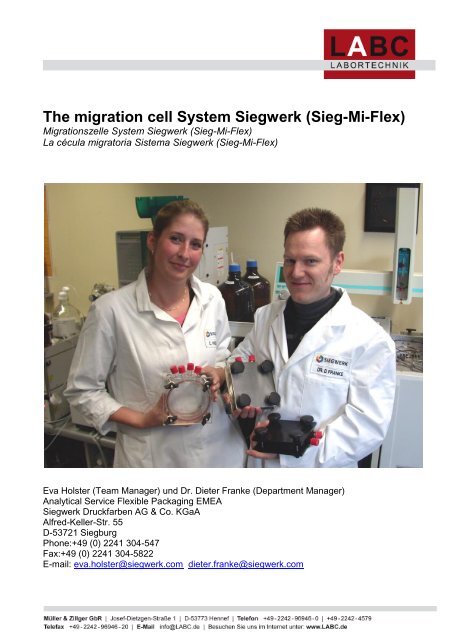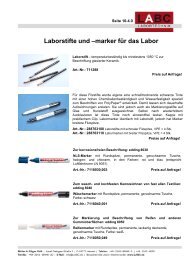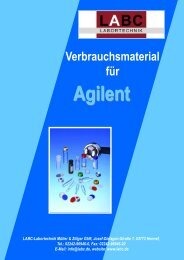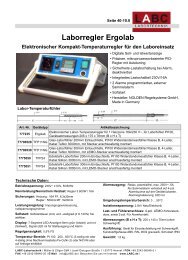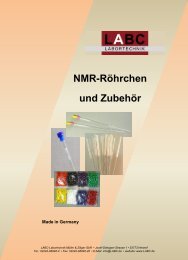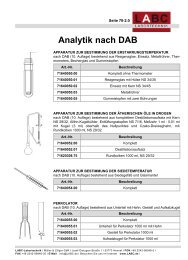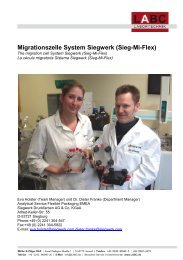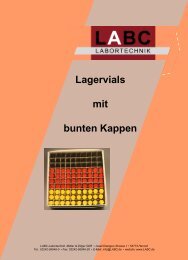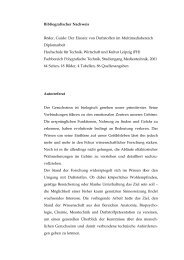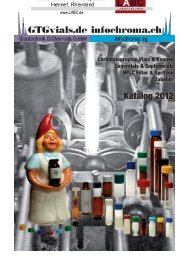The migration cell System Siegwerk - LABC Labortechnik
The migration cell System Siegwerk - LABC Labortechnik
The migration cell System Siegwerk - LABC Labortechnik
You also want an ePaper? Increase the reach of your titles
YUMPU automatically turns print PDFs into web optimized ePapers that Google loves.
<strong>The</strong> <strong>migration</strong> <strong>cell</strong> <strong>System</strong> <strong>Siegwerk</strong> (Sieg-Mi-Flex)<br />
Migrationszelle <strong>System</strong> <strong>Siegwerk</strong> (Sieg-Mi-Flex)<br />
La cécula migratoria Sistema <strong>Siegwerk</strong> (Sieg-Mi-Flex)<br />
Eva Holster (Team Manager) und Dr. Dieter Franke (Department Manager)<br />
Analytical Service Flexible Packaging EMEA<br />
<strong>Siegwerk</strong> Druckfarben AG & Co. KGaA<br />
Alfred-Keller-Str. 55<br />
D-53721 Siegburg<br />
Phone:+49 (0) 2241 304-547<br />
Fax:+49 (0) 2241 304-5822<br />
E-mail: eva.holster@siegwerk.com dieter.franke@siegwerk.com
Measurement of the <strong>migration</strong> of low-molecular substances<br />
from packaging´s by sample preparation with the <strong>migration</strong> <strong>cell</strong><br />
<strong>System</strong> <strong>Siegwerk</strong> (Sieg-Mi-Flex) and following analytical<br />
quantification.<br />
In the EU, for packaging with direct food contact, the standards of the EU regulation 1935/2004,<br />
Article 3, apply. <strong>The</strong> most important requirement basically states that all materials and objects shall<br />
be manufactured as to assure that their material components will only migrate in such small<br />
quantities that any possible health risks can be excluded.<br />
<strong>The</strong> <strong>migration</strong> <strong>cell</strong> <strong>System</strong> <strong>Siegwerk</strong> (Sieg-Mi-Flex) simplifies sample preparation while dealing with<br />
<strong>migration</strong> analytics. With these <strong>migration</strong> <strong>cell</strong>s, it is possible to achieve a <strong>migration</strong> estimation of lowmolecular<br />
substances, for example of food packaging, that takes place even right at the ready-made<br />
rolls. Owing to the flexibility of <strong>cell</strong> system, all sorts of samples can be analyzed with the correct<br />
choice of the liquid food simulant. After the preparation and storage of the <strong>cell</strong>s, according to the EU<br />
regulations, the simulant solutions can be quantified via the respective analytic methods (GC/MS,<br />
HPLC-MS, HPLC-DAD oder DC), or after a prior concentration of samples via SPE, SPME or rotary<br />
evaporation.<br />
<strong>The</strong> <strong>migration</strong> <strong>cell</strong> <strong>System</strong> <strong>Siegwerk</strong> (Sieg-Mi-Flex) includes a ring shaped volume element (center<br />
ring) that has sealing elements that are arranged at it´s frontal area (O-rings made of silicone,<br />
surrounded by FEP). <strong>The</strong> circular area is interrupted by two openings, that are filled with one filler<br />
pipe each. <strong>The</strong> filler pipe is eather sealed with a common laboratory screw with a cap and a GL<br />
thread or with a septum. <strong>The</strong> volume element is being braced between the front and the bottom<br />
plate by four screws, with the bolts having ergonomically formed handwheels. <strong>The</strong> circular volume<br />
element (center ring) is offered in different sizes, making it possible that the <strong>migration</strong> <strong>cell</strong> can be<br />
adjusted rapidly to the current trial area.<br />
Because of the modular construction of the <strong>migration</strong> <strong>cell</strong> (Sieg-Mi-Flex), an adaption of the <strong>cell</strong> for<br />
fixed adsorbents can be expected in the future.
Stainless steel <strong>migration</strong> <strong>cell</strong> <strong>System</strong> <strong>Siegwerk</strong> (Sieg-Mi-Flex)<br />
A transition of low-molecular substances from packaging to the filling material can take place in<br />
two different ways:<br />
1. In the batch or in the roll by set off.<br />
2. <strong>The</strong> <strong>migration</strong> of substances from the printed ink side through the foil material into the<br />
filling goods.<br />
For <strong>migration</strong> analysis of various samples, Eva Holster, Dr. Dieter Franke (<strong>Siegwerk</strong> Druckfarben<br />
AG & Co. KGaA) and Werner Zillger (<strong>LABC</strong> <strong>Labortechnik</strong>, Hennef) developed the <strong>System</strong><br />
<strong>Siegwerk</strong>(Sieg-Mi-Flex). It guarantees the highest possible flexibility regarding different surface<br />
sizes and structures of the samples.<br />
1. Central rings with smaller diameters than nom. width DN120 achieve flexibility in analysis<br />
of sample sizes. A fixing plate clamps the central ring into the housing made of stainless<br />
steel.<br />
2. Ergonomically formed plastic hand-wheels ensure an easy handling in locking and opening<br />
of the stainless steel <strong>migration</strong> <strong>cell</strong>s. Additionally, the compact and space saving design of<br />
these <strong>cell</strong>s allows horizontal or vertical storage e.g. for tempering in an oven.<br />
3. Flexible, chemical resistant FEP/Silicon O-<br />
rings are used for sealing elements. <strong>The</strong><br />
diameter of the filler necks is big enough for<br />
a practicable handling in filling the volume of<br />
the central ring. <strong>The</strong> volume ring can be<br />
closed/locked by temperature stable<br />
laboratory standard GL14 cylindrical cup.
Glass-Migration-Cell <strong>System</strong>-<strong>Siegwerk</strong> (Sieg-Mi-Flex)<br />
used for sample preparation in the measurement of <strong>migration</strong> of low molecular weight substances<br />
from packaging materials and subsequent analytical quantification.<br />
A transition of low-molecular substances from packaging to the filling material can take place in<br />
two different ways:<br />
1. In the batch or in the roll by set off.<br />
2. <strong>The</strong> <strong>migration</strong> of substances from the printed ink side through the foil material into the<br />
filling goods.<br />
For <strong>migration</strong> analysis of various samples, Eva Holster, Dr. Dieter Franke (<strong>Siegwerk</strong> Druckfarben<br />
AG & Co. KGaA) and Werner Zillger (<strong>LABC</strong> <strong>Labortechnik</strong>, Hennef) developed the glass<strong>migration</strong>-<strong>cell</strong><br />
“<strong>System</strong> <strong>Siegwerk</strong>”.<br />
v<br />
1. Middle rings from the same high made from borosilicate glass 3.3, with the nominal diameter<br />
of DN120 with the help of two plan glass-fixing-plates clamped.<br />
2. Ergonomically formed plastic hand-wheels ensure an easy handling in locking and opening<br />
of the glass steel <strong>migration</strong> <strong>cell</strong>. Additionally, the compact and space saving design of these<br />
<strong>cell</strong>s allow horizontal or vertical storage e.g. for tempering in an oven.<br />
3. Flexible, chemical resistant FEP/Silicon O-rings are used for sealing elements. <strong>The</strong> diameter<br />
of the filler necks is big enough for a practicable handling in filling the volume of the central<br />
ring. <strong>The</strong> volume ring can be closed/locked by temperature stable laboratory standard GL14<br />
cylindrical cup.<br />
Technical data from the glass-<strong>migration</strong>-<strong>cell</strong> <strong>System</strong>-<strong>Siegwerk</strong> :<br />
Two fixing plates and one central ringing with Nom. width (DN120), One-sided approx. contact area<br />
= 1,00 dm², Two-sided approx. contact area = 2,0 dm², Capacity 200ml.<br />
- 2 borofloat plates with holes, protective inserts for screws, bolts and nuts<br />
- 1 borosilicate glass ring with O-ring DN120-slots, 2 x GL14, ID max. 8.5 to 9 mm,<br />
Part No.: 715350: Price on request!
Eva Holster and Dr. Dieter Franke, member of<br />
analytical department <strong>Siegwerk</strong> Druckfarben AG &<br />
Co. KGaA, located in Siegburg remarked: „<strong>The</strong><br />
<strong>migration</strong> <strong>cell</strong> “<strong>System</strong> <strong>Siegwerk</strong>” offers an<br />
optimum of sealing between sample and <strong>cell</strong>s, a<br />
maximum conviniens in daily handling and<br />
guarantees the highest possible accuracy in<br />
<strong>migration</strong> analysis“.<br />
Technical data:<br />
<strong>The</strong> <strong>migration</strong> <strong>cell</strong> “<strong>System</strong> <strong>Siegwerk</strong>” consists of:<br />
One Fixing plate (A) and different central rings (B)<br />
of your choice.<br />
A) Fixing plate (fits all following central rings!):<br />
• Stainless steel (VA 1.4571) plates with threaded holes, inside<br />
polishes,<br />
• 4 x stainless steel bolt, plastic star nut and thread (DIN 125B A2)<br />
Part No.: 715318: Price on request!<br />
B) Central rings:<br />
• Stainless steel (VA 1.4571) in and filling connecting pieces with<br />
GL14 thread inclusive. Cover screw-cap GL14 (PBT housing +<br />
PTFE/Sil. - Seal)<br />
• 2 x O-ring FEP/Silicon suitable for groove in central ring (top and<br />
bottom)<br />
• Aluminium-positioning-plate (except for the nom. width DN120!)<br />
Central rings<br />
article No.<br />
Nom. width<br />
One-sided<br />
approx.<br />
contact area<br />
Two-sided<br />
approx.<br />
contact area<br />
Capacity<br />
(ml)<br />
715319 DN120 1.00 dcm² 2.0 dcm² ca. 200<br />
715328 DN110 0,95 dcm² 1,9 dcm² ca. 170<br />
715320 DN100 0.75 dcm² 1.5 dcm² ca. 150<br />
715329 DN90 0,60 dcm² 1,2 dcm² ca. 120<br />
715321 DN80 0.50 dcm² 1.0 dcm² ca. 100<br />
715322 DN70 0.35 dcm² 0.7 dcm² ca. 70<br />
715323 DN60 0.25 dcm² 0.5 dcm² ca. 50<br />
715324 DN30 0.05 dcm² 0.1 dcm² ca. 10<br />
Prices on request!
Sample preparation when analysing the <strong>migration</strong> of yogurt lids<br />
using the <strong>migration</strong> <strong>cell</strong> system <strong>Siegwerk</strong> (Sieg-Mi-Flex)<br />
To specify the <strong>migration</strong> measurement in mg/dm 2 it is practical to be able to work with a defined area as<br />
large as possible when preparing the sample. <strong>The</strong> <strong>migration</strong> <strong>cell</strong> system <strong>Siegwerk</strong> (Sieg-Mi-Flex) offers<br />
appropriate sizes to test the largest possible area of the most common yogurt lid (peel-off lid) diameters.<br />
<strong>LABC</strong>-<strong>Labortechnik</strong> produces customer-specific <strong>migration</strong> <strong>cell</strong>s on request.<br />
<strong>The</strong> top figure shows the system <strong>Siegwerk</strong> (Sieg-Mi-Flex)<br />
<strong>migration</strong> <strong>cell</strong>s with the central rings DN90 and DN70. <strong>The</strong>se<br />
are the optimum fit for the conventional yogurt lid diameters of<br />
95.5 mm and 75.5 mm.<br />
<strong>The</strong> bottom figure shows the system <strong>Siegwerk</strong> (Sieg-Mi-Flex)<br />
<strong>migration</strong> <strong>cell</strong>s with the central rings DN120 and DN110. <strong>The</strong>se<br />
are the optimum fit for aluminium yogurt lids with a diameter of<br />
125 mm and clip-on yogurt lids with a diameter of 115 mm.<br />
When analysing the <strong>migration</strong> of food packaging, the food simulants in the <strong>migration</strong> <strong>cell</strong> only come into<br />
contact with the materials stainless steel (VA 1.4571) and PTFE and therefore meet analytical<br />
requirements. <strong>The</strong> <strong>migration</strong> <strong>cell</strong> is resistant against all the food simulants listed in Commission<br />
Regulation (EU) No 10/2011 as well as against 3% acetic acid.<br />
Further information on food packaging:<br />
Overall <strong>migration</strong> limit (global <strong>migration</strong>) OML<br />
<strong>The</strong> maximum permitted amount of non-volatile substances released from a material or article into food<br />
simulants; expressed in mg/dm 2 .<br />
Specific <strong>migration</strong> limit (SML)<br />
<strong>The</strong> maximum permitted amount of a given substance released from a material or article into food or food<br />
simulants (SML = ADI x 60)<br />
Acceptable daily intake (ADI)<br />
Expressed in mg/kg. <strong>The</strong> amount of a toxicologically evaluated substance that can be consumed in<br />
foodstuffs on a daily basis without any risk to health ((toxicological concentration limit x safety factor 100).<br />
<strong>The</strong> <strong>migration</strong> of substances for which no toxicological data is available must fall below 10 μg/kg (ppb) in<br />
accordance with the Note of Guidance from the European Food Safety Authority (EFSA).<br />
(QM)<br />
<strong>The</strong> maximum concentration of a toxicologically evaluated substance in the packaging in mg/kg
Commission Regulation (EU) No 10/2011 of 14 January 2011 on plastic materials and articles<br />
intended to come into contact with food<br />
Commission Regulation (EU) No 10/2011 is a specific measure as defined by Article 5 (1) of Commission Regulation<br />
(EU) No 1935/2004. This Regulation should establish the specific rules for plastic materials and articles to be applied<br />
for their safe use. Furthermore, the Regulation should repeal Commission Directive 2002/72/EC of 6 August 2002 on<br />
plastic materials and articles intended to come into contact with foodstuffs. In the past, Directive 2002/72/EC and its<br />
amendments have had to be transposed into national legislation – a process for which a time period of 12 months was<br />
normally required. This led to a retardation of the authorisation for new substances and thus slowed down innovation.<br />
It therefore seemed appropriate to adopt rules on plastic materials and articles in the form of a Regulation directly<br />
applicable in all Member States, which no longer has to be transposed into national legislation.<br />
What are the key changes and features of this Regulation<br />
Expansion of the scope: compared to Directive 2002/72/EC, the scope has been extended to plastic layers in<br />
materials and articles with multi-material multi-layers.<br />
Union list of authorised substances (Annex I): Directive 2002/72/EC contains different lists for monomers or<br />
other starting substances as well as for additives authorised for the manufacture of plastic materials and articles. For<br />
monomers, other starting substances and additives, the Union list in Annex I is now complete. This means that only<br />
the 885 substances authorised at EU level and included in this list may be used to manufacture plastic materials and<br />
articles under consideration of their specific <strong>migration</strong> limits (SML).<br />
Restrictions on materials and articles (Annex II): Annex II specifies the specific <strong>migration</strong> limits for several<br />
metals (e.g. barium, iron and zinc) as well as for primary aromatic amines.<br />
Selection of the food simulants for specific <strong>migration</strong> (Annex III): new food simulants such as ethanol (10%<br />
v/v, 20% v/v and 50% v/v), vegetable oil and Poly(2,6-diphenyl-p-phenylene oxide) are to be used for <strong>migration</strong><br />
testing.<br />
Declaration of compliance: pursuant to Articles 15 and 16, at each stage of manufacture, supporting<br />
documentation substantiating the declaration of compliance should be kept available for the enforcement authorities.<br />
Link to Commission Regulation (EU) No 10/2011 of 14 January 2011:<br />
http://eur-lex.europa.eu/LexUriServ/LexUriServ.douri=OJ:L:2011:012:0001:0089:DE:PDF<br />
Other interesting links in relation to food packaging:<br />
Conformity of food packages, <strong>migration</strong> and invisible set-off (Technical information hubergroup, 19/01/2003):<br />
http://www.hubergroup.info/lang/deu/tipdf/19103D.PDF<br />
Online FAQ portal for <strong>migration</strong> (Dresden packaging conference):<br />
http://www.verpackungstagung.org/dvt-faq.html<br />
Migration of packaging contents in food, current legislation on printing on food packaging (CH, D, Europe) by Dr.Jörg<br />
Langhammer, Siegburg: http://www.dfta.de/media///dfta/veranstaltungen/dr.-langhammer.pdf<br />
Packaging printing: Best Practice Guide - Low Migration (SUN Chemical):<br />
http://www.druckfarben.net/Best_Practice_Guide_-_Low_Migration_D.pdf<br />
Migration of mineral oil from cardboard packaging into dry foods (Koni Grob, Cantonal lab Zürich):<br />
http://www.bfr.bund.de/cm/343/<strong>migration</strong>_von_mineraloel_aus_kartonverpackungen_in_trockene_lebensmittel.pdf<br />
Specifications within the scope of the food packaging chain (Dr. Sieglinde Stähle, Alliance for food right and food<br />
customer inc..): http://www.bll.de/themen/bedarfsgegenstaende/spezifikationen-lebensmittelverpackungskette.pdf
Headspace analysis of the <strong>migration</strong> of substances from packaging materials<br />
by means of sample preparation using the <strong>migration</strong> <strong>cell</strong> system <strong>Siegwerk</strong><br />
(Sieg-Mi-Flex) in ‘sandwich format’<br />
In the EU, packaging that comes into direct contact with food is subject to Commission Regulation (EU) No<br />
10/2011 of 14 January 2011 on plastic materials and articles intended to come into contact with food. In<br />
addition to the preparation of samples with liquid food simulants, the analysis of the headspace (steam<br />
chamber) is an interesting alternative for research & development. By using the ‘sandwich format’, the<br />
headspaces of the food contact side and the outer side can be measured simultaneously and free from the<br />
matrix of the food simulants. <strong>The</strong> sampling and analyte enrichment processes ideally occur using SPME (solid<br />
phase microextraction). An inert carrier gas can optionally be used to flush the steam chamber and the volatile<br />
substances can be concentrated on a test tube with an adsorbent.<br />
<strong>The</strong> ‘sandwich format’ of the <strong>migration</strong> <strong>cell</strong> (Sieg-Mi-Flex) also makes it possible to test the barrier properties<br />
(H 2 0, CO 2 ; O 2 ) of composite packaging. <strong>The</strong> film to be tested is placed between the two central rings and pulled<br />
taut. <strong>The</strong> GL14 threaded connections provide an inlet and an outlet for each steam chamber.<br />
To create the ‘sandwich format’ you need not only another central ring but also a threaded extension<br />
connection set (product no.: 715325) to double the reaction area of the <strong>migration</strong> <strong>cell</strong> ‘Sieg-Mi-Flex’.<br />
<strong>The</strong> film to be tested is placed between the two central rings and pulled<br />
taut. <strong>The</strong> GL14 threaded connections provide an inlet and an outlet for<br />
each steam chamber.<br />
Product no.<br />
Nominal<br />
diameter (mm)<br />
Area (dcm²) Total fill volume (ml) Quantity<br />
A: Fixing plate (suitable for use with all the central rings listed below!): VA 1.4571 Plates with<br />
threaded holes, polished inner, 4 x stainless steel bolts, plastic star nut and bolt DIN 125B A2<br />
715318 - - - 1<br />
B: Central rings: VA 1.4571, cast-in and cast-out connecting pieces with GL14 thread incl. cover cap<br />
GL14 (PBT housing + PTFE/sil. seal), 2 x O-ring FEP/silicone that fit in the central ring’s nut (top and<br />
bottom), aluminium positioning aid (except with DN120!)<br />
715319 DN120 2 x 1,00 dcm² approx. 2 x 200 2<br />
715328 DN110 2 x 0,95 dcm² approx. 2 x 190 2<br />
715320 DN100 2 x 0,75 dcm² approx. 2 x 150 2<br />
715329 DN90 2 x 0,60 dcm² approx. 2 x 120 2<br />
715321 DN80 2 x 0,50 dcm² approx. 2 x 100 2<br />
715322 DN70 2 x 0,35 dcm² approx. 2 x 70 2<br />
715323 DN60 2 x 0,25 dcm² approx. 2 x 50 2<br />
715324 DN30 2 x 0,05 dcm² approx. 2 x 10 2<br />
C: Threaded extension connection: threaded extension connection for doubling the reaction area in<br />
‘sandwich format’, 1 set = 4 complete threaded connections<br />
715325 - - - 1<br />
Prices on request!
Please request also for our special catalogues:<br />
CATALOG<br />
CATALOG<br />
50<br />
LaborGeneralkatalog<br />
Geräte & Laborverbrauchsgüter von VGKL<br />
100 Problemlösung für die <strong>Labortechnik</strong><br />
120 Feinchemikalien<br />
130 AAS-Zubehör und Geräte<br />
140 ICP-Zubehör<br />
150 Vials und Verschlüsse für die<br />
instrumentelle Analytik<br />
151 Vials & Caps für die instrumentelle<br />
Analytik - GTGvials<br />
160 Yeti Spritzenfilter<br />
170 Yeti Membranfilter<br />
180 Yeti Pumpenschläuche<br />
190 NMR-Röhrchen und Zubehör von Deutero<br />
270 Labor – Lösemittel im 5Light®<br />
(Laborlösemittelversorgung)<br />
280<br />
290<br />
300<br />
310<br />
320<br />
330<br />
335<br />
340<br />
350<br />
360<br />
370<br />
Laborchemikalien Generalkatalog<br />
Zubehör für Elementar- u. Futtermittelanalytik<br />
Agilent- herstellerspezifische<br />
Ersatzteile + Verbrauchsmaterial<br />
CTC-herstellerspezifische<br />
Ersatzteile + Verbrauchsmaterial<br />
Perkin Elmer- herstellerspezifische<br />
Ersatzteile + Verbrauchsmaterialien<br />
Verbrauchsmaterial für Shimadzu<br />
Verbrauchsmaterial für Varian<br />
Verbrauchsmaterial für Waters<br />
Verbrauchsmaterial für <strong>The</strong>rmo Finnigan<br />
Lagervials mit bunten Kappen<br />
Industrie- und Laborwaagen, Feuchtebestimmer,<br />
Pipettentester, Viskosimeter<br />
_ _ _ _ _ _ _ _ _ _ _ _ _ _ _ _ _ _ _ _ _ _ _ _ _ _ _ _ _ _ _ _ _ _ _ _ _ _ _ _ _ _ _ _ _ _ _ _ _ _ _ _ _ _ _ _ _ _ _ _ _ _ _<br />
We ask for recall<br />
Mr./Mrs. ...................................................... Company ...........................................................<br />
Phone ......................................................... Department: ......................................................<br />
Fax .............................................................<br />
E-Mail .........................................................<br />
Street …….........................................................<br />
Postal code/Place..............................................<br />
Datum ........................................................<br />
We thank for your trust!


